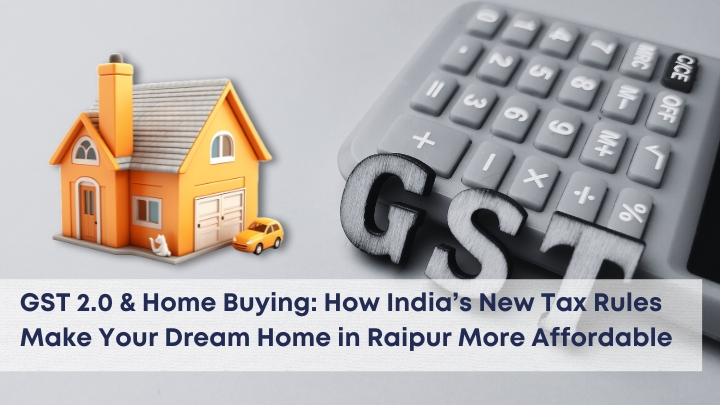Buying a home has always been one of the biggest milestones in an Indian’s life. It’s not just a financial decision — it’s a dream that represents security, pride, and belonging. But for many, the road to owning that dream home was never simple. Between fluctuating real estate prices, complicated taxation systems, and hidden costs, buyers often found themselves confused or burdened.
Then came GST, the Goods and Services Tax, which was introduced in 2017 as a single, unified tax system for India. While the first phase of GST brought transparency to many industries, the real estate sector continued to experience some challenges — especially for homebuyers struggling with tax calculations, double taxation, and complex paperwork.
Now, with GST 2.0, the government has refined the system, focusing on simplicity, affordability, and digital efficiency. And the results are already being felt, especially in the real estate market.
Let’s explore how GST 2.0 is reshaping India’s home-buying experience — and how these reforms make it easier than ever to buy your dream property in Raipur or any other Indian city.
1. The Need for GST 2.0 in Real Estate
The real estate sector was one of the largest contributors to India’s GDP even before GST. However, before the introduction of GST, the tax structure was fragmented. Buyers had to deal with multiple indirect taxes such as:
- VAT (Value Added Tax)
- Service Tax
- Stamp Duty
- Registration Charges
Each state had different tax rates, and developers often passed on these costs to buyers. This made pricing opaque and home buying less predictable.
When GST was first introduced in 2017, it aimed to simplify this system. But homebuyers still found themselves paying varying tax rates depending on whether the property was under construction or completed. Developers also struggled with input tax credits (ITC), and confusion persisted about what was and wasn’t taxable.
That’s where GST 2.0 steps in — designed to make real estate transactions more transparent, digital, and buyer-friendly.
2. What Is GST 2.0 and How Is It Different?
GST 2.0 isn’t a new tax — it’s an upgrade to the existing GST system, focused on better compliance, simpler filing, and improved benefits for both businesses and consumers.
Here’s how it changes the game for real estate:
- Simplified Return Filing System
GST 2.0 introduces automated return filing and reconciliation, meaning developers can now claim ITC easily and accurately. This ensures buyers don’t indirectly pay extra for errors or delays in the developer’s tax compliance. - E-Invoicing & Transparency
Every invoice is now recorded in the GST system in real-time through e-invoicing. This means no hidden costs, no manipulation, and full visibility of the taxes paid on your home purchase. - Input Tax Credit (ITC) Reform
One of the major highlights is the rationalization of ITC for real estate developers. Under GST 2.0, ITC tracking has become easier and more transparent. This allows developers to pass on more savings to buyers. - Digital Compliance and AI-Powered Monitoring
GST 2.0 uses AI tools to monitor tax filings and detect discrepancies. This creates a more trustworthy ecosystem — reducing fraud and promoting genuine developers.
3. The New GST Rates for Real Estate (After 2.0)
The government continues to maintain simplified tax slabs for real estate under GST 2.0:
| Property Type | Old GST Rate | New GST 2.0 Rate | Input Tax Credit |
| Affordable Housing | 8% | 1% | No |
| Non-Affordable Housing (Under Construction) | 12% | 5% | No |
| Ready-to-Move-In Property | Exempt | Exempt | N/A |
These revised rates ensure that buyers of affordable and mid-segment homes pay far less tax than before. For developers, the streamlined compliance process helps them reduce administrative costs and offer better deals to homebuyers.
4. How GST 2.0 Makes Home Buying Easier and More Affordable
A. Transparent Pricing
Earlier, buyers were often confused about what portion of their payment went toward taxes. With GST 2.0, all tax components are clearly shown on digital invoices, ensuring full transparency.
B. Reduced Construction Costs
Developers can now claim input credits more efficiently, lowering their project costs. This reduction is gradually passed on to homebuyers, especially in large housing projects.
C. Lower Tax Rate on Affordable Homes
For many first-time buyers, affordability is key. With GST at just 1% on affordable housing projects, owning a home in cities like Raipur, where property prices are already competitive, becomes significantly easier.
D. Faster Project Completion
GST 2.0’s simplified compliance means less paperwork and fewer delays in fund releases. This speeds up project timelines, ensuring that homebuyers get possession sooner.
E. Greater Trust in Developers
Because GST 2.0 includes AI-driven monitoring, it’s harder for developers to evade taxes or manipulate invoices. This boosts buyer confidence and promotes credibility across the sector.
5. Affordable Housing: The Biggest Winner Under GST 2.0
Affordable housing has been the government’s top priority under its “Housing for All” mission. With GST 2.0’s new tax rates and compliance ease, affordable housing developers can now offer better pricing without cutting corners on quality.
Buyers of 1BHK and 2BHK homes in emerging cities like Raipur, Nagpur, and Indore benefit the most. The reduced 1% GST rate, combined with state-level subsidies and PMAY (Pradhan Mantri Awas Yojana) incentives, makes these homes more attainable than ever.
6. Real Estate in Tier-2 Cities Like Raipur: The Emerging Hotspot
The Indian real estate market has been shifting beyond metro cities. Tier-2 cities such as Raipur, Bhopal, Lucknow, and Bhubaneswar are seeing increased demand due to better infrastructure, connectivity, and affordability.
GST 2.0 accelerates this shift by making home buying simpler and safer. For instance:
- Raipur’s housing market has grown steadily due to industrial expansion and affordable property prices.
- With the GST 2.0 regime, buyers in Raipur now enjoy transparent transactions and clear tax benefits.
- Developers can launch more projects with predictable tax compliance, improving overall market stability.
In short, GST 2.0 fuels a new wave of real estate growth in emerging Indian cities.
7. How GST 2.0 Benefits Homebuyers Directly
Let’s look at what buyers gain:
- Simplified Taxation: No need to juggle multiple tax categories — GST combines them all.
- Predictable Pricing: The all-inclusive tax rate helps you calculate total home cost easily.
- No Hidden Costs: E-invoices ensure every rupee is accounted for.
- Increased Trust: Transparent compliance builds buyer confidence.
- Improved Delivery: Developers spend less time on paperwork and more on construction.
For anyone buying an under-construction home, these reforms translate to real savings and peace of mind.
8. GST 2.0: A Boost for Developers Too
Developers are equally benefitting from GST 2.0. Earlier, they faced issues with delayed ITC refunds, manual filing, and mismatched invoices. Now, with automation, they can:
- File returns digitally with minimal errors.
- Manage cash flow more efficiently.
- Attract more buyers due to transparent pricing.
- Reduce compliance costs, which ultimately helps reduce property prices.
This synergy between developers and homebuyers strengthens the entire ecosystem.
9. The Bigger Picture: Government’s Vision for a Transparent Real Estate Ecosystem
GST 2.0 is more than just a tax update — it’s part of India’s broader digital governance vision. The idea is to make every financial transaction traceable, verifiable, and fraud-free.
In real estate, this means:
- Each payment made for a property is traceable through a GST-linked invoice.
- Fraudulent or fake developers can be easily flagged.
- Buyers have verifiable proof of tax compliance, protecting them legally.
This level of accountability is a major step toward transforming real estate into a digitally empowered and trustworthy sector.
10. Tips for Homebuyers to Make the Most of GST 2.0
If you’re planning to buy a home in 2025, here’s how you can benefit the most:
- Choose Registered Developers
Always buy from developers registered under GST. This ensures that your transaction is recorded, and you get full tax transparency. - Ask for the E-Invoice
Under GST 2.0, every legitimate developer must issue an e-invoice. Check that your invoice includes the GSTIN and QR code. - Compare Pre-GST & Post-GST Prices
Understand the difference in pricing structures to see how GST 2.0 reduces the tax burden. - Know Your Tax Slab
Identify whether your project falls under the affordable housing category to avail of the 1% GST rate. - Monitor ITC Benefits
Developers can pass ITC benefits to buyers — ensure you get your share of these savings.
11. How Raipur’s Real Estate Is Set to Flourish Under GST 2.0
Raipur, the capital of Chhattisgarh, has already become a preferred location for homebuyers due to its balance of modern infrastructure and affordable living. With GST 2.0, this growth will only accelerate.
- Buyers benefit from clear and uniform pricing.
- Developers find it easier to launch compliant projects.
- The government’s infrastructure push — such as Naya Raipur and upcoming smart city projects — aligns perfectly with GST 2.0’s transparent ecosystem.
In short, Raipur is poised to become a model city for affordable yet modern living.
12. The Future of Home Buying Under GST 2.0
As GST 2.0 continues to evolve, we can expect:
- Seamless integration of AI tools for fraud detection.
- Real-time homebuyer dashboards for tax tracking.
- Instant ITC settlement for developers.
- A shift toward fully digital property transactions.
These advancements will make buying property in India — especially in developing cities like Raipur — faster, safer, and more affordable than ever.
Conclusion: Your Dream Home, Simplified with GST 2.0 and VGR Real Estate
The journey to owning a home has always been emotional. But with GST 2.0, it’s now also simpler, transparent, and fair. Whether you’re a first-time buyer or an investor, the new system ensures you get clarity on every rupee you spend.
And when you combine these tax benefits with a trusted developer, the dream becomes reality.
That’s where VGR Real Estate comes in. Known for premium residential properties in Raipur, VGR focuses on transparent dealings, superior design, and customer trust — values that perfectly align with the spirit of GST 2.0.
So, as India enters a new era of digital transparency, VGR ensures your home-buying journey in Raipur isn’t just smoother — it’s smarter, more affordable, and built on trust.





